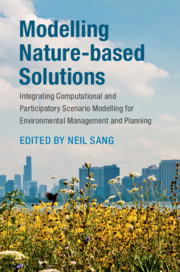 Modelling Nature-based Solutions
Modelling Nature-based Solutions Book contents
- Modelling Nature-based Solutions
- Modelling Nature-based Solutions
- Copyright page
- Contents
- Contributors
- Foreword
- Acknowledgements
- Introduction
- 1 Landscape Modelling and Stakeholder Engagement: Participatory Approaches and Landscape Visualisation
- 2 Agent-based Models of Coupled Social and Natural Systems
- 3 Modelling Nature-based Solutions from Soil Ecosystem Services
- 4 Modelling Water Resources for Nature-based Solutions
- 5 Models at the Service of Marine Nature-based Solutions
- 6 Coastal and Freshwater Flood Models: A Review in the Context of NBS
- 7 Nature-based Solutions to Urban Microclimate Regulation
- 8 Data Mining, Machine Learning and Spatial Data Infrastructures for Scenario Modelling
- 9 Can Geodesign Be Used to Facilitate Boundary Management for Planning and Implementation of Nature-based Solutions?
- 10 Integrating Models into Practice – Recommendations
- Appendix: List of Models/Software
- Index
- Plate Section (PDF Only)
- References
9 - Can Geodesign Be Used to Facilitate Boundary Management for Planning and Implementation of Nature-based Solutions?
Published online by Cambridge University Press: 13 March 2020
- Modelling Nature-based Solutions
- Modelling Nature-based Solutions
- Copyright page
- Contents
- Contributors
- Foreword
- Acknowledgements
- Introduction
- 1 Landscape Modelling and Stakeholder Engagement: Participatory Approaches and Landscape Visualisation
- 2 Agent-based Models of Coupled Social and Natural Systems
- 3 Modelling Nature-based Solutions from Soil Ecosystem Services
- 4 Modelling Water Resources for Nature-based Solutions
- 5 Models at the Service of Marine Nature-based Solutions
- 6 Coastal and Freshwater Flood Models: A Review in the Context of NBS
- 7 Nature-based Solutions to Urban Microclimate Regulation
- 8 Data Mining, Machine Learning and Spatial Data Infrastructures for Scenario Modelling
- 9 Can Geodesign Be Used to Facilitate Boundary Management for Planning and Implementation of Nature-based Solutions?
- 10 Integrating Models into Practice – Recommendations
- Appendix: List of Models/Software
- Index
- Plate Section (PDF Only)
- References
Summary
Ecosystem-based approaches are vital to addressing environmental issues and are crucial to buffering human communities against the adverse effects of climate change (Jones et al., 2012). The impacts of ecosystem-based projects have been considered within a range of societal challenge areas, such as wetland management (Max Finlayson et al., 2011), as well as across cross-cutting challenges of biodiversity conservation, public health and well-being (Kloos & Renaud, 2016). In most instances, researchers have drawn upon the ecosystem services framework for assessing the biophysical or economic value of ecosystem-based approaches (Liquete et al., 2015; Green et al., 2016), and for examining the potential for synergies and trade-offs between bundles of ecosystem services (Mouchet et al., 2017).
- Type
- Chapter
- Information
- Modelling Nature-based SolutionsIntegrating Computational and Participatory Scenario Modelling for Environmental Management and Planning, pp. 305 - 340Publisher: Cambridge University PressPrint publication year: 2020
References
- 2
- Cited by
